在数轴上代表√3
数轴是用于表示特定间隔的数字的线,用于简单的数值运算。自然数、整数、整数、有理数和无理数都是数字的类型。这些都是实数或实数行的一部分。所有这些数字都可以用数字线直观地表示吗?用于计数的零之后的正整数称为自然数。请记住,它们用符号“N ”表示。现在向这个集合添加零。您现在拥有由符号“W”表示的整数集合。现在零之前的大量负整数和整数的集合是所有整数的集合,它用符号'Z'表示。你可能想知道,为什么是 Z? Z来自德语单词“Zahlen”,意思是“数字”。数字行上是否还留有任何数字?是的,当然,有许多不同的数字,例如 1/3、-6352/371、25/6。如果所有这些数字都包含在整数集合中,那么它现在将是有理数集合。回想一下,有理数用'Q'表示。为什么问? Rational 来自“比率”这个词,Q 来自“商”这个词。有人可能想知道,无理数在这条数轴上的什么位置?不是有理数的数被归类为无理数。毕达哥拉斯学派,著名数学家和希腊哲学家毕达哥拉斯的追随者,是第一个发现无理数的人。
数字类型
有不同类型的数字。上面提到了整数、自然数、整数、有理数、无理数等。我们来看看关于这些具体类型的几点,
自然数
- 这些是用于计数的数字。
- 1、2、3、4……以此类推。
- 它们用符号“N”表示。
整数
- 整数是一组自然数,包括零 (0)。
- 例如。 9、35、100、0 等
- 它们用符号“W”表示。
整数:
- 整数是一组正数和负数,包括零。它们没有小数或小数部分。
- 例如。 24、-18、0、-1、8 等
- 它们用符号“Z”表示。
有理数
- 一组可以用 p/q 形式表示的数,其中 p 和 q 是整数,q 不等于 0,称为有理数。
- 例如。 25/5。 17/8,-3/8。
- 它们用符号“Q”表示。
无理数
- 不能以 p/q 形式表示的一组数,其中 p 和 q 是整数且 q 不等于 0,称为无理数。
- 例如。 Pi (π)、黄金比例 (1.618033….)、√2、√3 等。
- 它们用符号“P”表示。
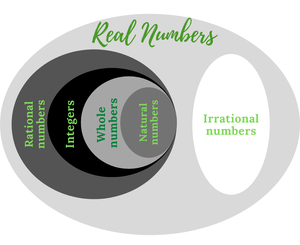
实数饼图
有理数和无理数的区别
首先要记住的是,有理数的小数位要么是终止的,要么是循环的。而无理数的小数位是非终止和非循环的。Rational numbers Irrational numbers 1. The decimal places are Terminating or recurring 1. The decimal places are Non-terminating and Non-recurring 2. Can be represented in the form p/q where p is an integer and q is not equal to zero 2. Cannot be represented in the for p/q, where p is an integer and q is not equal to zero. 3. Eg: 1.2, 3.567,-24.92, -18 3. Eg: √8, √11, √50, √3, √5
在数轴上代表√3
方法一
Representation of √2 on the number line
Step 1: Draw a line segment of 1cm anywhere on a number line.
Step 2: Mark the line segment A and B
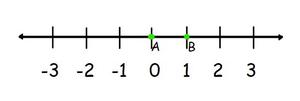
Step 3: Draw a line segment of 1cm perpendicular to AB, and mark the point C.
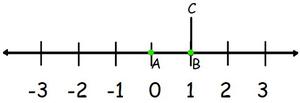
Step 4: Draw a line connecting A and C.
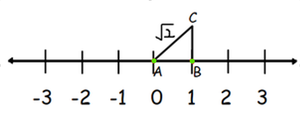
Step 5: AC is √(12 + 12) = √2

Representation of √3 on the number line
Step 6: Draw a line segment of 1cm perpendicular to AC. Mark the point D
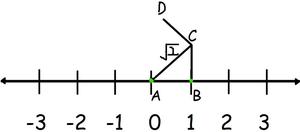
Step 7: Draw line connecting A and D.
Step 8: AD is √ {(√2)2 + (1)2}= √3
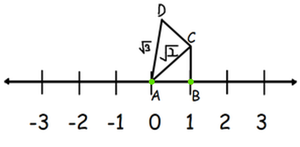
Step 9: Take a compass and take the radius to the length of AD.
Step 10: Extend the arc and mark where it touches the number line as E
Step 11: AE is √3
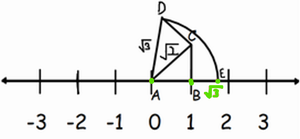
Similarly, locate √n for any positive integer n, after √n-1 has been located. Continue doing this for √4, √5, √6, etc. Square root spiral is obtained.
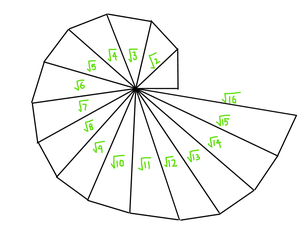
Square root spiral
方法二
Representation of √2 on the number line.
Method 1 is tedious and time-consuming. It is easy to use for smaller numbers. Therefore there is another easy way to represent irrational numbers on the number line which is less time-consuming and can also be used for larger numbers.
Step 1: Draw a line segment of n cm. In this case, it’s 2 cm, and mark them A and B.
Step 2: Extend B to C to form a line segment of 1cm.

Step 3: Take a compass, and mark an arch, placing one end of the compass in A. With the same radius, draw another arch placing one end of the compass in B.
Step 4: Mark the point of intersection between the arches as D.
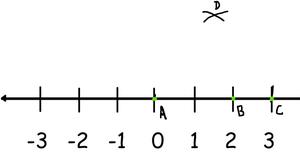
Step 5: Draw a perpendicular line joining D and AC. Mark this point as E.
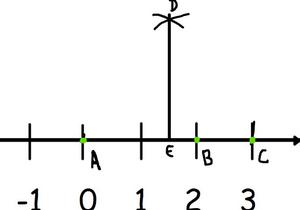
Step 6: Take AE as radius, and draw a semicircle.
Step 7: Draw a perpendicular line joining B and the semicircle, and mark the point F.

Step 8: BF is √2
Step 9: Take radius AF on the compass on extending it till the number line, and mark the point G.
Step 10: BG is √2 = 1.41421…
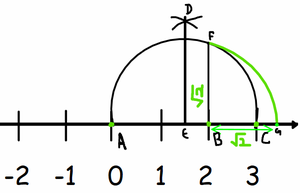
Using the same steps you can represent √n on the number line, by taking AB as n cm.
Representation of √3 on the number line
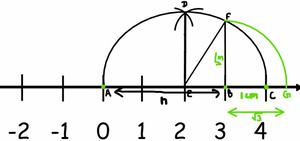
AB = n units, BC = 1 unit.
In this case, n = 3.
BF is = √n
We can prove this by using the Pythagoras Theorem. Note that △EBF is a right-angled triangle and the radius of the circle is (n + 1)/2 units. Therefore, EC = EF = EA = (n + 1)/2 units.
OB = n – (n + 1/2) = (n – 1)/2.
Applying the Pythagoras theorem,
(BF)2 – (EF)2 – (EB)2 = {(n + 1)/2}2 = (4n)/4 = n.
This proves that BF = √n.
示例问题
问题 1:数轴上 √4 的表示。
解决方案:
问题 2:数轴上 √5 的表示。
解决方案:

This construction gives us a visual, and geometric way of showing that √n exists for all real number n>0.
